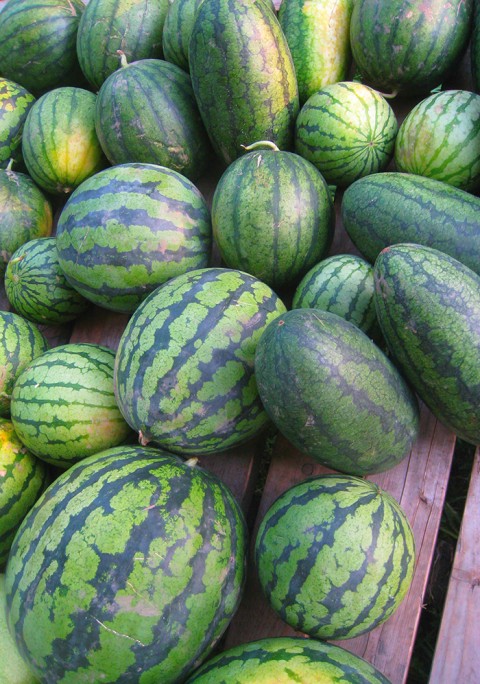Watermelons, watermelons everywhere
How does the blazing sun produce so much refreshing fruit?

I leap and lunge on tiptoe, zigzagging through the watermelon patch maze, trying not to step on any of the sprawling vines or shading leaves. The sun has set, but light reflecting from the clouds lets my brother Henry and his kids and me continue picking watermelons, which have suddenly ripened all at once. We load them into five-gallon buckets, then carry the heavy buckets to the truck to sort and pack the melons into crates before taking them to the shed, and ultimately to our farmers market and Community Supported Agriculture customers.
We are in the dog days of August, named after the Dog Star, Sirius, the brightest star in the sky, which now rises in the east just before dawn. The temperature is manageable for a few hours after Sirius fades to white, but soon the heat and humidity begin to beat us down.
Read our latest issue or browse back issues.
By mid-afternoon, a deathly stillness descends into the sheltered bottomland field—no breeze, no birdsong, no motion except for trickling sweat as we harvest tomatoes and peppers, eggplant and okra, green beans and summer squashes, and so much more.
“August creates as she slumbers,” Joseph Wood Krutch wrote, and it does seem that if you turn away from the field and then turn back, you witness, if not the miracle of the loaves and fishes, then the miracle of the corn and squashes. The plants you just got done harvesting seem laden once again with yellow crookneck and green zucchini, huge pink Brandywine and tiny Sungold tomatoes, Japanese cucumbers and Dragon Tongue beans—all of which need to be picked and washed and packed and sold, along with the less than perfect “for us” items that we gorge on, can, freeze, or otherwise preserve for winter.
The saving grace during the dog days of summer is the many different heirloom varieties of watermelon that Henry grows. Since he chooses them for taste, not transportability and shelf life, all have thin, fragile skins. When they’re ripe they are bursting (often literally) with flavor and goodness. Sometimes they crack open spontaneously in the field or at the slightest touch as Henry gently turns them over to gauge their ripeness. Others make it all the way to the wash area but then crack as we box them or load and unload them from the market truck. We feign disappointment when a melon cracks, but are secretly gleeful as we break it into ragged-edged chunks as if it were a giant loaf of bread, pass the chunks around, and bury our faces in them to half-eat, half-drink the sweet nectar, then spit out the seeds.
Yes, we grow only seeded watermelons, which over the past decade or so have gone from ubiquitous to endangered. I’m not sure if the seedless watermelon boom has been driven by consumers’ desire for the dubious convenience of seedlessness (although truth be told, “seedless” melons are full of tiny undeveloped white seeds) or by large-scale growers’ desire for a plant that matures quickly and uniformly. But we grow only seeded watermelons because when you surrender seeds you surrender flavor and the ability to save seeds and be self-sufficient in watermelons. One of Henry’s favorite melons is the large Golden Producer, which seed catalogs stopped carrying years ago. But because the melon has seeds, we have saved and planted them year after year.
But the main reason we plant seeded melons is because these have exquisite flavor—robust and complex, with sweet floral, citrus, vanilla, and even herbal notes. And they come in all colors, from pale cream to bright yellow and orange, to bright red, to the red and yellow Sorbet Swirl watermelon. No matter the color, all are so juicy and flavorful that after eating some we are instantly revived even on the most brutal of August days.
It always seemed strange to me that the blazing sun produces the cooling melon. But when I learned that watermelons are native to Africa, most likely originating in present-day Egypt, Sudan, and Libya, it finally made sense. The vigorous roots go deep and wide to gather all the water they can and pull it into the fruit. Then, when the fruit and seeds are mature, the watermelon bursts so that the moisture from the fruit facilitates the seeds’ germination and ensures another generation of watermelon.
Botanists have determined that wild watermelons were round, hard, and bitter—but prized as a source of water in an arid land. At some point—through random mutation along with human selection and propagation—the round, bitter melons became oblong and sweet. We know this because in 4,000-year-old Egyptian tomb paintings, the watermelon is already oblong, with the lighter and darker green patterned skin of modern melons.
We know even more about ancient watermelons from three Jewish law codices from around 200 AD. One ancient Hebrew text puts watermelons in the same category as figs, grapes, and pomegranates—all sweet fruits. Another text on tithing stipulated that watermelons should be placed in a single layer, not stacked, which means they must have had fragile rinds similar to the heirloom melons Henry grows.
By the time Europeans “discovered” watermelons, they had already spread throughout Africa, the Middle East, India, and Asia. They were brought to America by early European colonists and were common in Massachusetts as early as 1629. A few decades later, the Florida Indians were growing them, and before long, watermelons had made it to the interior of the continent through tribes trading seeds with each other. As Père Marquette traveled down the Mississippi River to the Arkansas River and then back up the Illinois River in 1673, he noted that the Indians were growing watermelons, even though the nearest white settlement was 600 miles away. It is safe to assume that watermelons have been growing in Illinois ever since, and we are continuing the tradition.
As darkness finally ends the long, hot harvest day, the air cools and our moods brighten. I leave the watermelon patch with a cracked melon in each hand and can’t wait to get home and see if I agree with Mark Twain, who proclaimed that to taste a watermelon is to know “what the angels eat.”
A version of this article appears in the September 28 print edition under the title “Watermelon heaven.”






